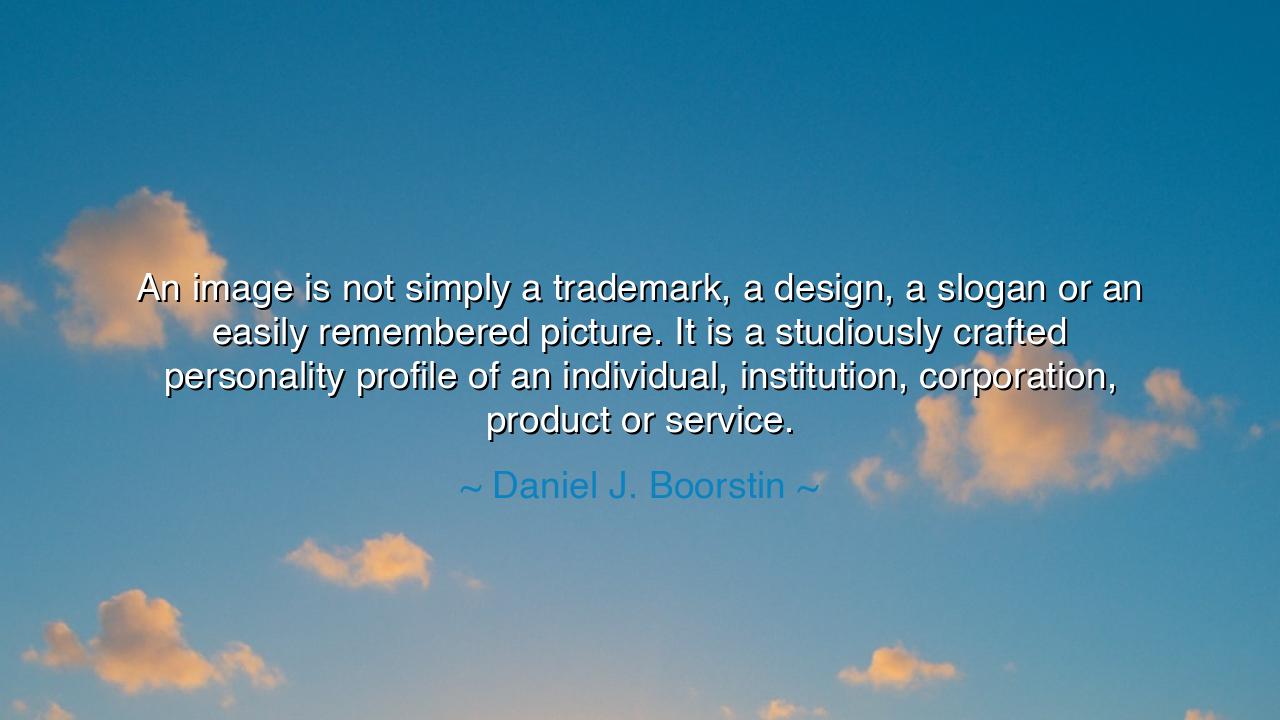
An image is not simply a trademark, a design, a slogan or an
An image is not simply a trademark, a design, a slogan or an easily remembered picture. It is a studiously crafted personality profile of an individual, institution, corporation, product or service.






“An image is not simply a trademark, a design, a slogan or an easily remembered picture. It is a studiously crafted personality profile of an individual, institution, corporation, product or service.” — Daniel J. Boorstin
Hear, O listener of ages, and understand that in these words, Daniel J. Boorstin, the historian and philosopher of culture, unveils one of the profound illusions of the modern world. When he spoke of image, he was not speaking of the surface alone—the bright colors, the polished logo, or the alluring phrase—but of a deeper art: the crafting of perception, the shaping of how the world feels about a name, a face, a thing. For an image, as he declares, is not mere ornament—it is the mask of identity, molded through intention, labor, and subtle persuasion. It is a portrait, not of reality, but of what reality wishes to be.
Boorstin wrote in an age when mankind began to trade not in goods, but in impressions. In the marketplace of the twentieth century, the image became the new currency of power. A leader was no longer judged by deeds alone, but by the gleam of cameras and the cadence of his speech. A company no longer sold its product, but the dream it represented. Thus arose the age of manufactured identity, where every act—political, artistic, commercial—was shadowed by the question: “How will it appear?” In this, Boorstin saw both genius and danger. For he knew that behind every radiant image might lie emptiness, and behind every illusion, a forgotten truth.
To understand his warning, look to the story of Napoleon Bonaparte. He was not merely a conqueror of nations, but a master of image. He had himself painted as Caesar reborn, sculpted as the hero of destiny, dressed in robes that fused imperial majesty with revolutionary zeal. Through portraits, proclamations, and parades, he built not only an empire of land but an empire of perception. His armies fought with guns, but his legend fought with symbols—and for a time, the legend proved stronger. Yet when the man fell, the image endured, and even his defeat could not destroy it. Thus we see the truth of Boorstin’s words: the image is not an afterthought of power, but a form of power itself.
And so it is in our time, when images flash faster than thought and shape the minds of millions before reason awakens. The image of a corporation now walks before its product; the persona of a leader stands before his policy; the brand of a person precedes the person themselves. Each of these, Boorstin reminds us, is not born by accident—it is studiously crafted, woven from gestures, words, colors, and associations. Behind every symbol is a thousand small choices, made with care or with cunning, to guide the heart’s response. The image becomes the myth of the modern world, and myths, once believed, are difficult to unmake.
Yet Boorstin did not counsel despair. His insight was not condemnation, but a call to awareness. For though images can deceive, they can also uplift. A well-forged image, built upon truth and authenticity, can illuminate the values of a people or the spirit of a cause. Consider Mahatma Gandhi, whose image—plain robes, walking staff, gentle face—was as powerful as his words. He understood, perhaps instinctively, that to move hearts, one must embody simplicity and moral strength. His appearance became his philosophy made visible. Thus the image, when rooted in truth, becomes not a lie, but a mirror of the soul.
The lesson, then, is this: be conscious of the images you create, and wary of the ones you consume. For in the age of appearances, it is easy to mistake the mask for the man, the logo for the life. Ask yourself—does the image I present reflect what I am, or only what I wish to seem? Build your reputation not as an illusion, but as a vessel of your values. When your actions and your image are one, you will no longer need to advertise who you are; your character will shine through the surface, clear as sunlight through glass.
So, children of the future, remember Boorstin’s wisdom: every image is a story told about the self. Tell yours with integrity. Craft not the picture that flatters, but the one that endures. Let your image be a faithful reflection of your truth—an expression of purpose, not performance. For while the image may travel faster than reality, only authenticity reaches eternity.






AAdministratorAdministrator
Welcome, honored guests. Please leave a comment, we will respond soon